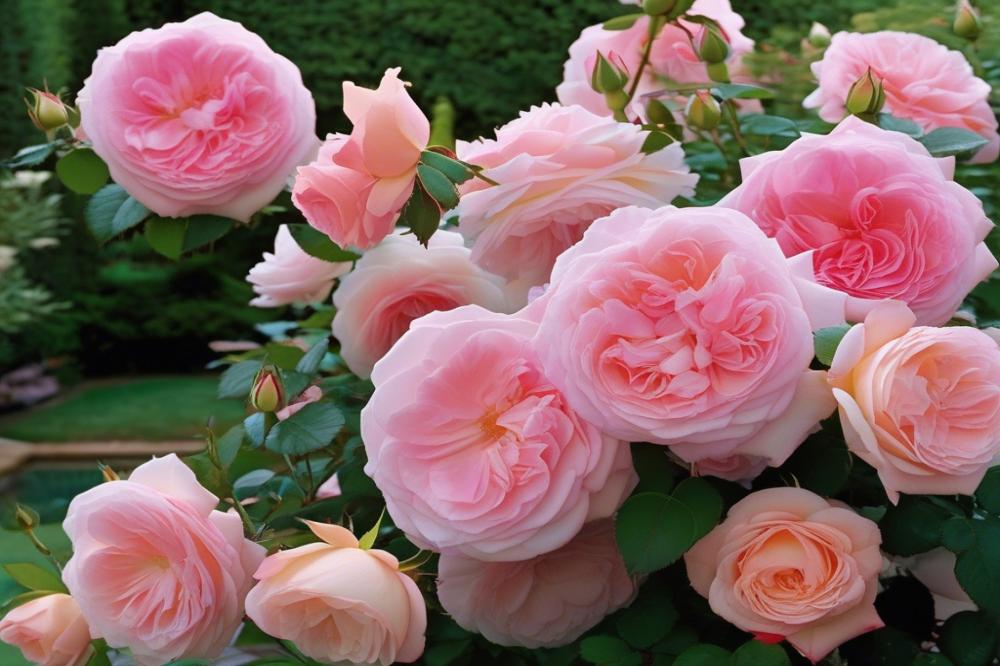Introduction to Cecile Brunner Roses
Cecile Brunner Roses are charming, petite blooms that never fail to captivate. Known for their delightful fragrance and graceful climbing habit, they add both beauty and elegance to gardens. This variety stands out due to its vibrant color and bushy growth. Many gardeners cherish these roses for their ability to flourish in various conditions.
The popularity of this rose variety is evident in gardens around the world. Gardeners are drawn to their lovely appearance and remarkable disease resistance. Additionally, many appreciate their strong climbing ability, making them perfect for trellises and fences. These roses thrive when properly cared for, and understanding their specific needs is essential for success.
Proper care plays a critical role in the growth of Cecile Brunner Roses. From soil preparation to watering, every aspect is important. pruning is another essential practice. It encourages new growth and keeps plants healthy. Attention to sunlight requirements and fertilizing roses can make a significant difference too. Regular pest control also cannot be overlooked, as it protects these fragile flowers from harm. By focusing on each of these elements, anyone can enjoy a robust and flourishing rose garden. Embrace the challenge of rose care, and you will maximize your enjoyment of these lovely plants.
Growing Cecile Brunner Roses

Ideal Conditions for Growing Cecile Brunner Roses
A successful garden begins with the right environment. These charming blooms thrive in USDA hardiness zones 5 to 9. A well-drained location is essential. Avoid areas with poor drainage to reduce the risk of root rot. Consider planting them near a fence or trellis. This allows the roses to climb and flourish beautifully.
Sunlight Requirements for Healthy Growth
Sunlight plays a vital role in the health of these roses. Ideally, they should receive at least six hours of direct sunlight each day. Morning sun helps dry the leaves and reduce disease risks. Too much shade can lead to weak plants with fewer blooms. Monitor their location to find the best balance of light.
Soil Preparation Techniques for Optimal Drainage and Nutrients
Soil health is crucial for strong growth. Prepare your garden bed with organic material such as compost. This enriches the soil and improves drainage. Aim for a slightly acidic to neutral pH level, around 6.0 to 7.0. Testing the soil is a smart move. Add amendments like peat moss or aged manure as needed to enhance fertility.
Understanding Climbing Nature of Cecile Brunner Roses
Cecile Brunner roses are known for their climbing tendencies. Understanding this characteristic helps in planning their placement. They can grow up to 12 feet high, so allow space for vertical growth. pruning plays a significant role in maintaining their shape. If you manage their growth, these roses can cover arches, walls, or arbors elegantly.
Pest control is also a concern. Regularly inspect for signs of trouble. Watch for aphids or spider mites. Quick action can save your plants from damage. When watering, be consistent but not excessive. Deep watering encourages stronger roots and disease resistance. Propagation through cuttings is another great way to expand your collection. Happy gardening!
Watering and Fertilizing Cecile Brunner Roses

Best Practices for Watering Cecile Brunner Roses
Watering plays a vital role in growing roses. Providing the right amount of water can make a significant difference. A deep watering is preferable over frequent light watering. This ensures that roots are well-hydrated and penetrates the soil adequately. Drip irrigation is a great option for maintaining consistent moisture without drowning the plant. Water in the early morning to minimize evaporation. Avoid getting water on the leaves to reduce the risk of disease.
Importance of Consistent Moisture Levels
Maintaining consistent moisture levels is key for healthy plant growth. Fluctuations can lead to stress, which may reduce blooms. A consistent watering routine encourages robust root systems. Mulching around the base of the plant will help retain moisture. It also keeps weeds at bay, allowing the plant to absorb nutrients more efficiently. Observe the soil’s moisture level regularly. Feel the top inch; if it’s dry, it’s time to water again.
Recommended Fertilizers for Enhancing Growth
Choosing the right fertilizers can immensely improve rose health. A balanced fertilizer that contains all essential nutrients will foster vigorous growth. Organic options like compost can enhance soil texture too. Look for slow-release formulas that feed plants gradually. Incorporating bone meal can also be beneficial for root development. This helps produce a stronger plant, leading to more beautiful blooms.
Fertilizing Schedule for Strong Blooms
Creating a fertilizing schedule is equally important. Early spring marks the ideal time to start feeding. As new growth appears, apply fertilizer every 4-6 weeks. This guarantees that your climbing roses have ample nourishment during their blooming phase. Cease fertilizing by mid-summer to allow the rose to harden off before fall. Regular pruning will also aid in promoting airflow and removing any dead material. Keeping pest control in mind is crucial. Proper care ensures strong disease resistance, allowing roses to flourish beautifully.
Pruning Cecile Brunner Roses

Timing and Techniques for Effective Pruning
Pruning is crucial for healthy growth. Late winter or early spring is the best time to start. This timing allows the plant to recover before the blooming season begins. Use sharp, clean shears to make your cuts. Aim to remove any dead or damaged stems first. Focus on shaping the plant as you go. Cut back to a healthy bud or joint. Maintaining an open center promotes airflow and sunlight.
Importance of Pruning for Shape and Health
Regular pruning promotes not just health but also a handsome appearance. It encourages new growth, which leads to more blooms. Removing old wood helps the plant direct energy to younger branches. A well-shaped rose plant is visually appealing and less prone to disease. Taking care of your climbing roses with regular pruning makes them more manageable. Remember, a little effort in pruning goes a long way in maintaining vigor.
How to Handle Spent Blooms to Encourage New Growth
After flowering, it’s important to address the spent blooms. Remove these faded flowers by cutting just above the highest five-leaflet leaf. This technique is known as deadheading. New growth can be stimulated through this simple act. Others prefer to wait until the end of the flowering season to prune more heavily. Fertilizing roses after deadheading encourages robust growth and prepares plants for the next season.
When proper care is given, these roses blossom beautifully year after year.
Pest Control and Disease Resistance

Common Pests Affecting Cecile Brunner Roses
A variety of pests can target these charming climbing roses. Aphids often appear first, sucking the juices from leaves. Spider mites may also infest, creating tiny webs that signal trouble. Additionally, thrips can distort flowers and hinder their full bloom. Identifying these pests early is crucial to minimize their impact on your roses.
Integrated Pest Management Strategies
Using integrated pest management (IPM) can really help in maintaining healthy plants. Start by encouraging beneficial insects, such as ladybugs, that eat pests. Regular inspections assist in noticing issues before they escalate. Introducing natural insecticides, like neem oil, offers a safe option to control infestations. Furthermore, rotating plant locations can disrupt pest life cycles, adding another layer of defense.
Overview of Disease Resistance
Disease resistance is an important feature when considering varieties of roses. Cecile Brunner generally displays a commendable level of resistance to common diseases like powdery mildew and black spot. However, this doesn’t mean they are invulnerable. Proper care, including regular watering and disease monitoring, will help bolster their resilience. More than just beauty, strong plants fight off illness effectively.
Preventive Measures to Maintain Plant Health
Taking precautions greatly enhances the health of your roses. Pruning regularly not only shapes the plant but also promotes better air circulation. Adequate sunlight is essential; roses thrive under at least six hours each day. Soil preparation should include nutrients that support proper growth and flowering. Keeping an eye on moisture levels when watering helps avoid both under- and over-watering. These straightforward steps can lead to vibrant, sturdy plants.
Propagation of Cecile Brunner Roses
Different Methods of Propagation
There are various ways to propagate this beauty. One common method is taking cuttings. This technique involves snipping healthy stems from an existing plant. Another approach is layering. This method requires bending a stem down to the ground and covering it with soil. Some might choose to start from seeds. While this method may take longer, it can still yield lovely plants. Each method has its own charm, but cuttings tend to be the most popular among gardeners.
Step-by-Step Guide for Successful Propagation
For those who prefer cuttings, here is a simple guide to follow. First, select a healthy stem from a mature plant. Look for one that is about six inches long and has several leaves. Next, make a clean cut at a 45-degree angle. This helps the cutting absorb water more effectively. Remove the lower leaves, leaving only a couple at the top. Now, dip the cut end in rooting hormone if you have it. This can speed up the development of roots.
Prepare a pot with quality potting mix. Adding some perlite can improve drainage and aeration. Insert the cutting into the soil, burying it about two inches deep. Water the soil gently, ensuring it’s moist but not soggy. Cover the pot with a plastic bag or use a mini greenhouse to help create a humid environment. Place the pot in indirect sunlight. Keeping it in a bright, warm spot is essential for growth.
After a few weeks, you can check for roots by gently tugging on the cutting. If you feel resistance, it’s rooting. Once established, gradually acclimate the new plant to direct sunlight. This step is crucial to avoid shock.
Tips for Nurturing New Plants Until Established
Watering the cuttings regularly is important. The soil should stay consistently moist, but not overly wet. Too much water can lead to rot, which is a common problem. Be mindful of reducing humidity as they get bigger. It helps the plants adapt to the outside conditions.
Fertilizing roses is not necessary right away. Wait until you see new growth. At that point, using a diluted, balanced fertilizer can promote healthy development. Pruning may also be beneficial. Snip off any dead or yellowing leaves to encourage vigorous growth.
Pest control should also be on your radar. Keep an eye out for common pests like aphids. If detected, use insecticidal soap or a strong spray of water to dislodge them. Selecting disease-resistant varieties can save a lot of headaches later.
As your roses grow, maintain proper sunlight requirements. These plants thrive in at least six hours of sunlight daily. Understanding this allows gardeners to find the best spots in their yards. Remember, patience is key in this process. With some care and attention, your new plants will flourish beautifully.
Wrapping Up Your Journey with Cecile Brunner Roses
Taking care of these beautiful flowers involves a few essential steps. Regular watering is crucial, especially during dry spells. Mulching helps keep the soil moist and protects the roots. Pruning enhances their growth and keeps them healthy. Remember to check for pests and diseases frequently. They thrive on attention and care, so don’t hesitate to spend time nurturing them.
You will find joy in the process of growing roses. Watching your garden bloom with soft pink flowers can be a rewarding experience. Invite friends over to admire your hard work. Share stories of your gardening adventures. Create a space where you can unwind and connect with nature.
Ultimately, these roses bring special charm to any garden. Their delicate fragrance and vibrant blooms add elegance wherever they grow. Gardening can be a journey of growth, both for you and your plants. Embrace the effort and celebrate your successes. The beauty of your garden will surely reflect your dedication.



